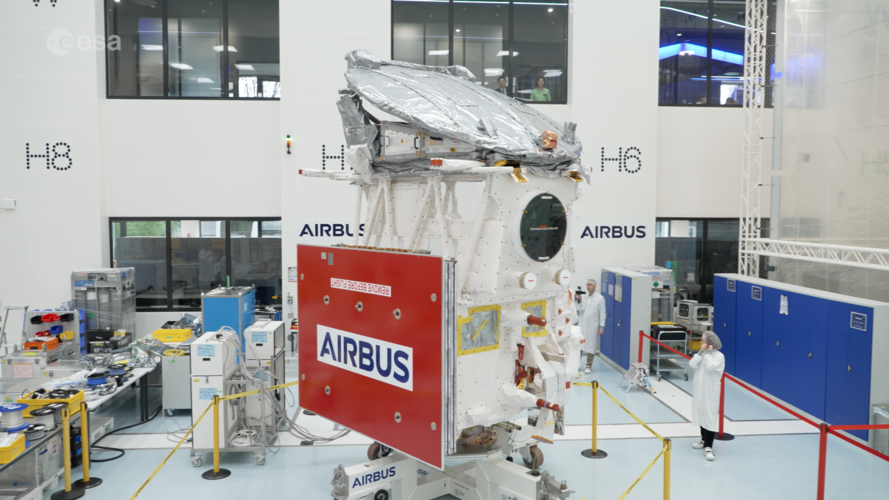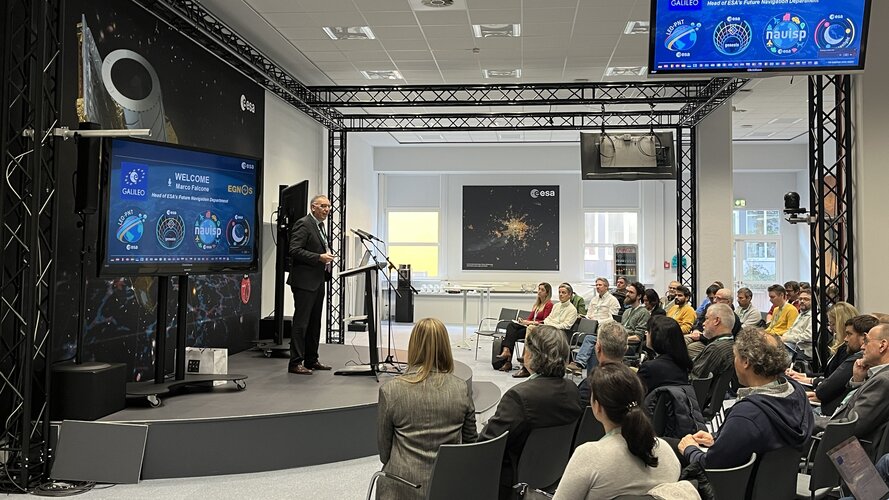EarthCARE bids adieu to Europe
Friday, 08 March 2024 10:00 Video:
00:03:29
Video:
00:03:29
After years of development and a rigorous testing programme, ESA’s EarthCARE satellite has left Munich, Germany, and is now on its away to SpaceX’s launch site in Vandenberg, California. Once it arrives, it will be put into storage for a few weeks until it is time to ready the satellite for liftoff – which is scheduled to launch in May on a Falcon 9 rocket.
The Earth Cloud Aerosol and Radiation Explorer, or EarthCARE for short, is the most complex Earth Explorer mission to date. The new satellite will look at the role that clouds and aerosols play in heating and
The geodetic community meets Genesis
Friday, 08 March 2024 09:45
The first Genesis science workshop brought together the ESA project team and the scientific geodesy community to establish the Genesis Scientific Exploitation Team and to set the ground for future collaboration.
Space-enabled connectivity steers self-driving cars
Friday, 08 March 2024 09:12
In one of the longest-running trials of a self-driving vehicle, collecting data over 13 000 km of autonomous travel, Darwin Innovation Group has been testing a novel driverless shuttle bus at Harwell Science and Innovation Campus, in Oxford, UK; home to ESA’s European Centre for Space Applications and Telecommunications (ECSAT). The technology is funded under the ESA 5G/6G Programme with the support of the UK Space Agency.
Conversations with ESA Directors on International Women’s Day
Friday, 08 March 2024 08:00
For International Women's Day 2024, we're acknowledging the remarkable careers of the women in key Directorate positions at ESA: Simonetta Cheli, Geraldine Naja and Carole Mundell. Read about the impactful work, pivotal life experiences and their insights on fostering a more inclusive future.
Earth from Space: Ireland
Friday, 08 March 2024 08:00 Image:
The lush landscape of the island of Ireland and the coasts of Scotland, Wales and England, are pictured in this view from the Copernicus Sentinel-3 mission.
Image:
The lush landscape of the island of Ireland and the coasts of Scotland, Wales and England, are pictured in this view from the Copernicus Sentinel-3 mission. Rocking robotics training
Friday, 08 March 2024 07:19 Image:
ESA astronaut candidate Raphaël Liégeois from Belgium during a robotics session as part of his basic astronaut training at ESA’s European Astronaut Centre, near Cologne, Germany.
Image:
ESA astronaut candidate Raphaël Liégeois from Belgium during a robotics session as part of his basic astronaut training at ESA’s European Astronaut Centre, near Cologne, Germany. How do animals react during a total solar eclipse? Scientists plan to find out in April
Friday, 08 March 2024 06:23
Full Disclousre: Enhanced Radiation Warnings for Space Tourists
Thursday, 07 March 2024 20:40 In a groundbreaking study led by space weather experts at the University of Surrey, there's a growing call for immediate action to safeguard the burgeoning space tourism industry from the invisible threat of cosmic radiation. The study, recently published in Space Policy, emphasizes the urgent need for collaboration between regulators and space tourism companies to enhance passenger and crew pro
In a groundbreaking study led by space weather experts at the University of Surrey, there's a growing call for immediate action to safeguard the burgeoning space tourism industry from the invisible threat of cosmic radiation. The study, recently published in Space Policy, emphasizes the urgent need for collaboration between regulators and space tourism companies to enhance passenger and crew pro Teledyne e2v HiRel Unveils New S-Band Ultra-Low Noise Amplifier for Space Missions
Thursday, 07 March 2024 20:40 Teledyne e2v HiRel has announced the launch of its latest product - the TDLNA2050SEP, a radiation-tolerant S-Band low noise amplifier. This product stands out in the market for its exceptional performance tailored to meet the rigorous demands of space and radar applications, where every component's reliability, efficiency, and size play a critical role in the success of the mission.
Develo
Teledyne e2v HiRel has announced the launch of its latest product - the TDLNA2050SEP, a radiation-tolerant S-Band low noise amplifier. This product stands out in the market for its exceptional performance tailored to meet the rigorous demands of space and radar applications, where every component's reliability, efficiency, and size play a critical role in the success of the mission.
Develo GITAI tests robotic construction of lunar comms tower in desert simulation exercise
Thursday, 07 March 2024 20:40 GITAI USA Inc. (GITAI), a leader in space robotics innovation, has successfully showcased its advanced robotics technology through the construction of a 5-meter-high communication tower. This achievement was realized in a desert environment meticulously designed to simulate the lunar surface, representing a "first of its kind" demonstration in space robotics.
GITAI, in a collaborative effo
GITAI USA Inc. (GITAI), a leader in space robotics innovation, has successfully showcased its advanced robotics technology through the construction of a 5-meter-high communication tower. This achievement was realized in a desert environment meticulously designed to simulate the lunar surface, representing a "first of its kind" demonstration in space robotics.
GITAI, in a collaborative effo UMaine researchers use GPS-tracked icebergs in novel study to improve climate models
Thursday, 07 March 2024 20:40 Over the last four decades, warming climate and ocean temperatures have rapidly altered the Greenland Ice Sheet, creating concern for marine ecosystems and weather patterns worldwide. The environment has challenged scientists in their attempts to measure how water moves around and melts the ice sheet because equipment can be destroyed by icebergs floating near the glaciers.
Collected using
Over the last four decades, warming climate and ocean temperatures have rapidly altered the Greenland Ice Sheet, creating concern for marine ecosystems and weather patterns worldwide. The environment has challenged scientists in their attempts to measure how water moves around and melts the ice sheet because equipment can be destroyed by icebergs floating near the glaciers.
Collected using Office of Space Commerce considers restoring orbital debris regulations for commercial remote sensing licensees
Thursday, 07 March 2024 19:52

AI makes a rendezvous in space
Thursday, 07 March 2024 19:32
Space travel is complex, expensive, and risky. Great sums and valuable payloads are on the line every time one spacecraft docks with another. One slip and a billion-dollar mission could be lost. Aerospace engineers believe that autonomous control, like the sort guiding many cars down the road today, could vastly improve mission safety, but the complexity of the mathematics required for error-free certainty is beyond anything on-board computers can currently handle.
In a new paper presented at the IEEE Aerospace Conference in March 2024 and published on the preprint server arXiv, a team of aerospace engineers at Stanford University reported using AI to speed the planning of optimal and safe trajectories between two or more docking spacecraft.





